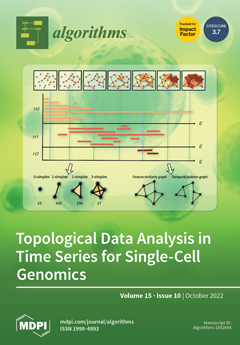The multiple knapsack problem (0/1-mKP) is a valuable NP-hard problem involved in many science-and-engineering applications. In current research, there exist two main approaches: 1. the exact algorithms for the optimal solutions (i.e., branch-and-bound, dynamic programming (DP), etc.) and 2. the approximate algorithms in
[...] Read more.
The multiple knapsack problem (0/1-mKP) is a valuable NP-hard problem involved in many science-and-engineering applications. In current research, there exist two main approaches: 1. the exact algorithms for the optimal solutions (i.e., branch-and-bound, dynamic programming (DP), etc.) and 2. the approximate algorithms in polynomial time (i.e., Genetic algorithm, swarm optimization, etc.). In the past, the exact-DP could find the optimal solutions of the 0/1-KP (one knapsack,
n objects) in O(
nC). For large
n and massive
C, the unbiased filtering was incorporated with the exact-DP to solve the 0/1-KP in O(
n +
C′) with 95% optimal solutions. For the complex 0/1-mKP (
m knapsacks) in this study, we propose a novel research track with hybrid integration of DP-transformation (DPT), exact-fit (best) knapsack order (
m!-to-
m2 reduction), and robust unbiased filtering. First, the efficient DPT algorithm is proposed to find the optimal solutions for each knapsack in O([
n2,
nC]). Next, all knapsacks are fulfilled by the exact-fit (best) knapsack order in O(
m2[
n2,
nC]) over O(
m![
n2,
nC]) while retaining at least 99% optimal solutions as
m! orders. Finally, robust unbiased filtering is incorporated to solve the 0/1-mKP in O(
m2n). In experiments, our efficient 0/1-mKP reduction confirmed 99% optimal solutions on random and benchmark datasets (
n δ 10,000,
m δ 100).
Full article





